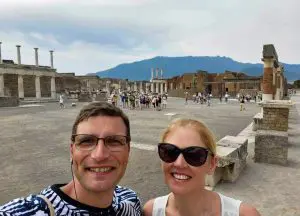 Having spotted an incredible bargain for the Amalfi Coast, we immediately knew we wanted to go. Yes, we dreamed of driving along the beautiful coastal road and taking in the Italian sunsets on the beach. But one of the biggest draws for us was going to see the Pompeii Archaeological Park. We had visited once before during a cruise, but felt it was a little rushed and we didn’t take in the full experience. So, staying in the area gave us the perfect opportunity to really dive into everything that this incredible ruin has to offer.
Having spotted an incredible bargain for the Amalfi Coast, we immediately knew we wanted to go. Yes, we dreamed of driving along the beautiful coastal road and taking in the Italian sunsets on the beach. But one of the biggest draws for us was going to see the Pompeii Archaeological Park. We had visited once before during a cruise, but felt it was a little rushed and we didn’t take in the full experience. So, staying in the area gave us the perfect opportunity to really dive into everything that this incredible ruin has to offer.
For most people visiting this area in Italy, Pompeii is a must on their list of places to see. If you’re not aware of the history of this archaeological park, then you may have been living in a cave, because pretty much everyone knows about the disaster which struck the poor citizens of this city.
Ad Disclaimer!
This website uses paid adverts and affiliate links, these come at no additional cost to you and help us to fund the operation of the website, meaning we can continue to provide you with valuable content.
The money received from these links and adverts do not influence any recommondations made within our content.
Page Contents
History of Pompeii and the Eruption
To give a brief history of Pompeii, it was founded by the Oscan’s in around the 8th century BC on the southern slopes of Mount Vesuvius and along the banks of the Sarno River. Because of its location it became a rapidly growing commercial centre which intrigued the invading Greeks from around 740 BC and then the Etruscans from 542 BC.
The Etruscans were conquered, and this led to Pompeii being taken over by the Samnites in the 5th century BC. During this time the city walls were expanded and fortified which allowed Pompeii to grow rapidly, especially as it was the main export of olive oil and wine.
In 80 BC at the end of the Samnite Wars, the city fell under Roman dominance, and it was during this time it reached its architectural and economic success. Pompeii was said to be the most popular recreational and resort town of the Roman aristocracy. Wealthy families are known to have flocked to live there, and buildings such as the Temple of Fortuna Augusta and the Building of Eumachia are examples of the city’s prosperity.
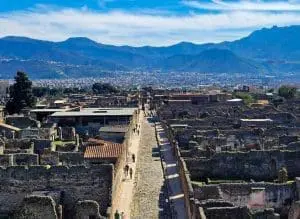 What you may not know is that Pompeii was seriously damaged by a strong earthquake in 62 AD, but under Emperor Nero work to rebuild quickly began.
What you may not know is that Pompeii was seriously damaged by a strong earthquake in 62 AD, but under Emperor Nero work to rebuild quickly began.
Sadly, and more notably the cities demise happened on the 24th August 79 AD when Mount Vesuvis erupted and covered Pompeii in at least 19 feet (6 metres) of ash and other volcanic debris. The fragments of ash and pumice caused the roofs of many of the houses to cave in and surges of pyroclastic material and heated gas soon asphyxiated any residents who hadn’t been killed by the falling debris. Additional pyroclastic flows as well as ash fell onto the city which led to the preserving of victims and much of the remaining architecture.
Archaeologists have determined that before the volcano erupted there were around 20,000 people living in the city. From studying the skeletal remains there were approximately 2,000 people who died during the eruption. They either chose not to leave the city, or they didn’t leave early enough, with the volcano’s activity covering a twenty-four-hour period.
Interestingly excavation of the city began as early as 1748 under King of Naples Charles III of Bourbon. He felt the excavation would add some prestige to the royal house, but sadly it wasn’t done with any scientific or systematic process. This changed at the beginning of the 19th century during French occupation, when the excavation work increased, although it was halted with the return of the Bourbon kings. It was during this time that they discovered the House of the Faun and its beautiful mosaic depicting the Battle of Alexander at Issus. This led to an increased desire to begin work again at the site, but this time they used both scientific methodology and careful record keeping, alongside plaster casting. Now you know a little about Pompeii and its history, we’ll go through our day at the archaeological site.
Transport to Pompeii
Pompeii is one of the worlds most visited archaeological sites, with over 3 million visitors a year. The first thing you will need to consider is how you’re getting to the ruins, because there are a number of options. We chose to drive because we already had a hire car, and we enjoyed the convenience of arriving and leaving when we wanted to.
If you’re unsure about driving and you’d like more information, then check out our guide on ‘Renting and Driving a Hire Car in the Amalfi Coast and Naples Region’. We go through the whole process of renting the car, picking it up at Naples airport and our tips on driving around the area.
By Car
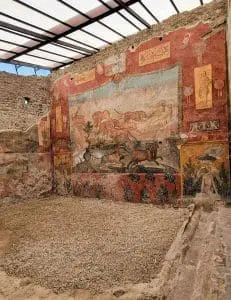 If you have chosen to drive, then the highway Autostrada (A)3 Pompeii Ovest will take you directly to the archaeological park entrance. There are a number of private car parks dotted around the area, and we chose one which was a short walk to the Porta Marina entrance. It was nice, well maintained and even had toilets which you could use at a small charge. The walk from the car park to Porta Marina is quite short, but we continued to walk to the Piazza Anfiteatro entrance thinking it would be quieter. In all honesty the queue was pretty much the same, but Porta Marina is much bigger with more ticket booths so we may have gotten in quicker had we gone there.
If you have chosen to drive, then the highway Autostrada (A)3 Pompeii Ovest will take you directly to the archaeological park entrance. There are a number of private car parks dotted around the area, and we chose one which was a short walk to the Porta Marina entrance. It was nice, well maintained and even had toilets which you could use at a small charge. The walk from the car park to Porta Marina is quite short, but we continued to walk to the Piazza Anfiteatro entrance thinking it would be quieter. In all honesty the queue was pretty much the same, but Porta Marina is much bigger with more ticket booths so we may have gotten in quicker had we gone there.
Driving is the ideal option if you want the freedom to go to other attractions after, for example we did Pompeii and Herculaneum in the same day. But you will have the car park costs to pay, although from memory the one we used wasn’t too extortionate. Depending on the time of year you visit they can fill quickly, so maybe look at pre-booking a space.
By Train
As to whether you visit Pompeii by train will depend on where you are staying during your trip. Places such as Naples and Sorrento have direct routes on the Circumvesuviana line and it’s the Pompeii Scavi-Villa dei Misteri station you will be looking for. The train is generally every 30 minutes, and it takes half an hour from Sorrento to Pompeii, and 45 minutes from Naples.
Once you’re off the train then you will see the entrance to the ruins of Pompeii directly opposite. We were shocked by how close the train station was, and how convenient it is. Of course, if you’re staying in a hotel on the coastal road, getting the train is going to be incredibly difficult and that’s probably where a private tour operator would be a better option.
Buses
The bus system in that area is called SITA and the route you take will obviously depend on where you are leaving from. There are bus schedules available online, but just be aware that to reach some of the more coastal towns, you may need more than one bus. Also, during the busier times of year, the buses can be full, and you may have to wait for the next one. If you have chosen public transport for your Amalfi trip, then to visit Pompeii we would recommend a tour instead.
Private Tours
If you’re looking for the easiest option and you’re not driving during your trip, then a private tour may be the ideal choice. This means you can just sit back and enjoy the journey to Pompeii and then follow the tour guide as they take you to all the best bits of this huge archaeological site. There are pros and cons with this option, mainly if you head in on your own then you have the opportunity to wander around freely and see whatever you like, but you’ll need the audio guide to learn about the city. If you go with a guide then you’re being told about Pompeii and the life of the people who lived there, but you’ll only see specific areas because it’s such a vast place.
Our advice is to use a guide for your first trip and then if you’re lucky enough to visit again, just wander around and take in the sights that the tour guides don’t head to. We have used Viator a number of times to book excursions during our travels. Taking a look at their site they offer a raft of Pompeii related tours at pretty reasonable prices.
Pompeii Entrances, Opening Times and Buying Tickets
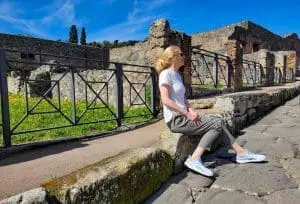 We made the decision to head into the Pompeii Archaeological Park early, because even though it was the low season we knew it would still be busy. It turns out that we were right, because there were lots of school groups on tours. As we mentioned above, after parking the rental car we headed to the Piazza Anfiteatro entrance thinking it would be quieter.
We made the decision to head into the Pompeii Archaeological Park early, because even though it was the low season we knew it would still be busy. It turns out that we were right, because there were lots of school groups on tours. As we mentioned above, after parking the rental car we headed to the Piazza Anfiteatro entrance thinking it would be quieter.
Outside the entrances to Pompeii, you’ll find a number of eating places and tourist information spots. If you haven’t brought any lunch with you then don’t worry, there are cafes and stalls dotted around. Most of the information and ticket offices can be found outside Porta Marina and it’s where most people head to. But if you have the time then take a moment and head to the Piazza Anfiteatro, because close by is the Hotel Vittoria and attached to that is a cameo shop called Cellini Gallery. We visited the shop on our first visit to Pompeii and it’s a wonderful experience. You can see then making cameo jewellery and then there’s a large shop downstairs full of jewellery at a range of prices. We purchased a ring made of volcanic stone for 5 Euros and we absolutely love it.
Top tip – If you haven’t brought water or a drinks container with you, then buy a bottle at one of the cafes or stalls before you enter Pompeii.
The opening times to the ruins will depend on the time of year you visit, so it’s probably best to check out the website. But in general, if you go between April and October you can visit between 9am and 7pm, and from November to March it is 9am to 5pm.
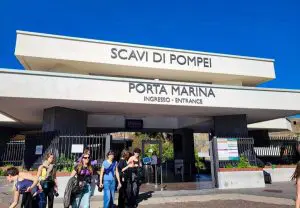 There are three entrances to the Pompeii site, and they are.
There are three entrances to the Pompeii site, and they are.
- Porta Marina (via Villa dei Misteri) – This is the main entrance for visitors, mainly because it is close to the majority of the private car parks and opposite to the Pompeii Scavi train station. The entrance offers a number of facilities including a shop to buy souvenirs, an information kiosk and luggage lockers. Porta Marina is also the entrance for those with mobility issues because there is a specific path which you can use for wheelchairs etc, to explore the ruins. We saw a lady in a wheelchair who attempted to work around the cobbles, and it was pretty much impossible.
- Piazza Esedra (Piazza Porta Marina Inferiore) – Close to the Porta Marina entrance but it is reserved for group tours and as such is less crowded.
- Piazza Anfiteatro (Piazza Immacolata) – This was the entrance we used and it’s about 15 minutes’ walk from the Porta Marina entrance. This one also has a number of facilities including an ATM, bookshop and toilets, plus there is a dedicated path for people with mobility issues.
You can buy your tickets on the day, or (especially in the peak season), it may be wiser to buy them online beforehand at pompeiisites.org. We bought them at Pompeii itself and as such had to queue for longer. As we queued there were tour guides stood to the side offering their services, they are available between 9am and 3pm. They are freelance guides who can be recognised by their badges, and you must agree prices, routes and the duration of visit with your guide before you enter the site.
We didn’t use their services but if you want a tour, we recommend pre-booking with a company who you have researched. You will find that the price will be cheaper, and you can check out the reviews beforehand to make sure they know what they’re doing and the route that is covered.
Top Tip – If this is your first visit then we would recommend a tour guide, with the option of having some private wandering time after. This was our second visit to Pompeii, the first being as part of a cruise. During our first visit we found the tour to be a little short because the guide only took us to specific sections of the archaeological park. So, on our second visit we wanted to simply walk around and see as much as possible without a time limit.
If you prefer the idea of walking around Pompeii yourself, then there is the option of renting an audio guide. We’ve read hit and miss reviews on them, some people saying they break easily. Now we had read on the official website that we could get an audio guide from the Porta Anfiteatro entrance. But when we asked, we were told that it was only available from the Porta Marina entrance. There are downloadable apps which are free so that is a great option, or if you want to hire them from the park then currently (March 2024) its 6.50 Euros each or 10 Euros for two. When you walk around the ruins you will see prompts to begin playing the audio guide.
When it comes to buying your ticket, you will be asked whether you want the full ticket or a Pompeii Express ticket. The full ticket covers the ancient city itself and the suburban villas, including the Villa of the Mysteries, Villa of Diomedes, and the Villa Regina in Boscoreale with Antiquarium and it is 22 Euros (March 2024). The Pompeii Express doesn’t include the suburban villas and is 18 Euros. We chose the full ticket because it was a mere 4 Euros difference and although we didn’t realise what extras it included when we bought it (we couldn’t quite understand the lady at the ticket office), it turned out to be worth it. There is a 3-day ticket which includes other sites, but you can discover more about it on their website.
Visiting Pompeii Archaeological Park
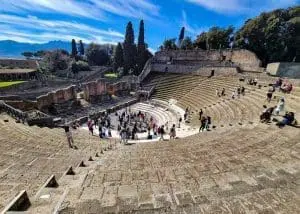
So, the best way to begin explaining our visit to Pompeii is to give you an idea of how vast the city was, because the archaeological ruins cover around 440,000 square meters which would take 3 full days to explore completely. We spent between 3 and 4 hours in there before we got really tired, because it was a warm day and it’s a lot of walking, mostly on cobbles or uneven paths.
Currently only 35 percent of the city which is about 500 buildings is open to the public, and these include shops, businesses, private villas, public buildings, temples, and squares or gathering places. If you’re short on time then the best thing to do is plan a faster itinerary of the key sites, which will give you an idea of what life was like in this incredible city.
But if you’re wandering around yourself, then make sure you are given a map when you purchase your ticket, because as you’re probably gathering, Pompeii is huge. The map is sectioned off into different areas and the main sites are indicated on there. You will see an image of a person laid down (that’s the best way for us to describe it) and it’s in those locations where you will find the casts of the victims of the disaster.
Some of the more popular buildings we’d recommend seeing during your visit are the Teatro Grande, which is a 20,000 seat large theatre, the forum, the basilica, the small theatre, the Odeion, the large Palaestra and the Saminite Palaestra. The Forum will provide you with an opportunity to sit down and take in the views, because it’s an open area with the beautiful landscape surrounding you, and yes that does include the imposing sight of Vesuvius in the background.
One of the more popular buildings for visitors is the Lunpanar which was the official brothel of Pompeii. There is some interesting artwork on the walls and concrete beds in small rooms dotted around. You may find that you have to queue to see this one, but it’s worth a visit.
We’d also recommend checking a tower out, because Pompeii had twelve of them and they were used with the walls and gates as fortifications against invaders. But climbing to the top of a tower will give you that new perspective of the site, because you can see miles and miles of ruins beneath you.
As well as the public buildings it was great to visit the many private villas because most of them have retained their original decorations. These include the Villa of the Mysteries, the House of the Faun, the House of the Orchard, the House of Venus in the Shell, the House of the Vettii, the House of the Tragic Poet, and the Villa of Diomedes.
Because we had bought the full ticket, we could head to the area which we could only describe as the posh section, because these were villas owned by the wealthy citizens of Pompeii. The extra buildings are the Villa of the Mysteries and the Villa of Diomedes. You are required to show your ticket to a member of staff at a ticket office before entering that section of the site, so make sure you keep it handy. For us personally this section was interesting, but we wouldn’t pay for it a second time. We preferred the other areas such as the smaller homes, the theatres and shops.
The Victims of Pompeii – Plaster Casts
 If you’re interested in seeing the plaster casts of the victims who lost their lives in the eruption, then our recommendation is to head to the Garden of the Fugitives. This area can be found towards the outer wall of the site not far from the Teatro Grande. During excavation this area revealed the highest number of recovered victims, with thirteen bodies seemingly trying to flee the disaster, found under the volcanic ash, forever preserved in their final moments. There are other areas where plaster casts can be found, but this one displays the impact to those who stayed too long.
If you’re interested in seeing the plaster casts of the victims who lost their lives in the eruption, then our recommendation is to head to the Garden of the Fugitives. This area can be found towards the outer wall of the site not far from the Teatro Grande. During excavation this area revealed the highest number of recovered victims, with thirteen bodies seemingly trying to flee the disaster, found under the volcanic ash, forever preserved in their final moments. There are other areas where plaster casts can be found, but this one displays the impact to those who stayed too long.
Because the Garden of the Fugitives was closed during our visit, we instead went to the other areas to view the plaster casts, such as the Stabian Thermal baths, the Macellum (fish market) and the Horrea (granary). You may be surprised to know that there are casts of animals found within the city. We saw the bones of a horse and you will also find casts of a pig and a small dog with a collar writhing on its back.
What we loved most about our visit to Pompeii was the chance to wander around the ordinary streets of the ancient town. The rows and rows of ruins which once were workshops, stores or even gathering areas such as bars. As we walked around it felt like Pompeii had been frozen in time and we felt privileged to have the opportunity to look into the past, but we also had a realisation that this civilisation was so advanced in their architecture and technology.
Obviously, we don’t want to tell you too much, because you’ll want to discover the mosaics, frescoes, and sculptures yourself. Just be aware that they regularly close specific sections of the ruins for maintenance work, so if you’re eager to see one specific thing, it may be closed. But the majority of the main buildings will always be open.
Antiquarium – Pompeii Museum
Once you’ve enjoyed your walk around the park itself, then make sure you head over to the Antiquarium which is a small museum that is included in your ticket price. Although many of the artifacts which were recovered from Pompeii have been moved to the Archaeological Museum of Naples and in the Museum of Boscoreale, there are still some interesting pieces within the Antiquarium. This includes architectural decorations, sculptures, mosaics, frescoes, and some plaster casts of people caught in the eruption. It’s a great end to your whole experience and a nice bit of shelter from the sunshine.
Facilities in Pompeii
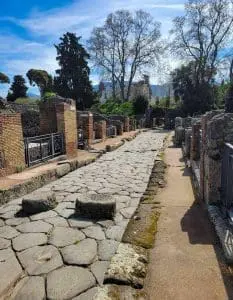 There are facilities available throughout Pompeii and we’ll go through them a little here.
There are facilities available throughout Pompeii and we’ll go through them a little here.
- Toilets Facilities – You will find toilets near the entrances of Piazza Anfiteatro, Piazza Esedra and Porta Marina. There are additional toilets throughout the ruins near the Casina dell’Aquila, the Antiquarium, Quadriportico, The Chora Cafe, the Villa of the Mysteries and before the entrance to the Antiquarium below the Temple of Venus.
- Food and Drink – They have added a small refreshment point not far from the Forum, behind the Temple of Jupiter. It’s called Chora and they offer a raft of hot and cold food and beverages. It gets pretty busy, so our advice would be to take your own if you can.
- First Aid – You will spot a first aid office not far from the Chora Café which is near the forum area. They have trained professionals there to assist should you need it.
- Cloakroom Service – We only spotted this as we left the site, but there are free luggage and cloakroom lockers at the Porta Marina area. Bags, backpacks, luggage or cases with dimensions exceeding 30x30x15cm are not allowed in Pompeii’s archaeological site, in an effort to protect the frescoes and rooms, but also to guarantee everyone’s safety. Because of this you will be asked to leave any large bags within the lockers provided, but they can fill up fast during busy times of the year. So, try to limit what you take with you to the site, because who would want to lug their cases along cobble stones anyway?
- Smoking Area – You cannot smoke on the excavation sites, but there are designated areas near the Casina dell’Aquila and the toilet facilities.
- Bookshop – There are a few shops dotted around Pompeii which predominantly sell books. You’ll find one at the entrance to Piazza Esedra and then there is one at the Antiquarium.
- Information office – Should you have any questions or concerns then you can find the Pompeii Excavations tourist information office by the Villa dei Misteri.
Pompeii Tips – Things to Know Before Visiting
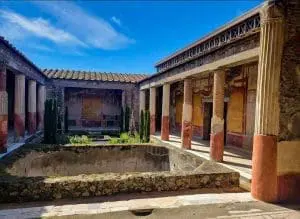 Pompeii is such an incredible experience, but it can be a tiring day, especially if you visit in the summer. So here are a few tips to make it more comfortable.
Pompeii is such an incredible experience, but it can be a tiring day, especially if you visit in the summer. So here are a few tips to make it more comfortable.
- Wearing comfortable shoes is a must – As we mentioned, the area of the ruins is VAST and the majority of it is cobble stones and large pavements. These uneven walkways can really have you aching by the end of the day, so make sure you have supportive, comfy footwear.
- Take a hat – We messed up and took our baseball caps but left them in the car. Thankfully it was a cloudy day, but when the sun came out, we certainly felt it. Bear in mind we visited in March, so imagine the sun in June or July. The problem with Pompeii is that there is very little shade as you walk around, so you’re in the sun for the majority of the day and that can lead to sunstroke, so prevention is key. We’d also add in here that you may want to throw on lots of sunscreen and keep reapplying, so you don’t get burnt.
- Take water with you – Because of the lack of shade, you will dehydrate quickly so it’s important that you keep your water levels topped up. We took water in with us, but you can always buy more when you’re in there at Chora. There are 40 water fountains scattered around Pompeii and the water is suitable for drinking and free. So, if you took a container or water bottle with you, you could refill at no cost. We’ve had sun stroke before, and it can make you incredibly ill and really ruin your holiday.
- Give yourself the full day – We get it, there’s so much to do around the area of Amalfi and you want to see it all. But Pompeii is such an important part of the Amalfi experience that you want to give it the adequate amount of time. We don’t believe you will need a full day, but depending on your mobility and how long you spend in each section, we can certainly imagine that you’d be there for four to five hours.
Should I Visit the Pompeii Ruins?
Many people visiting the Amalfi coast tend to only stay for a few days, so you may be wondering ‘is it worth losing a day to Pompeii?’ Honestly, yes! If you love this type of history and you’re intrigued by ancient architecture, then it’s worth the visit. The price of Pompeii is incredibly cheap when you consider everything you will get to see. We couldn’t believe the sheer size of the city, bearing in mind that you’re only seeing 35 percent of it. If you are short on time, especially if you’re based in Naples then we would recommend booking a tour, because they can give you the basics and transport you there and back. But for those of you who have longer in the area, then give Pompeii the time it deserves to be explored. We had been told Herculaneum, which was also affected by the volcano blast, was a better site, so we felt the need to rush through Pompeii and head over there. Our personal opinion is that it wasn’t any better, in fact knowing what we know now, we’d have rather stayed at Pompeii and continued to wander around.
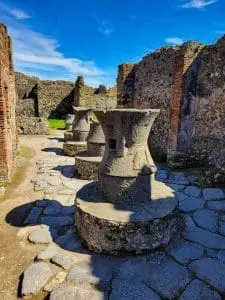 The way you choose to get to Pompeii is completely dependent on how you’re getting around the rest of the coast. We travelled by car, and it was easy enough to drive to the site and park up, but we were shocked at how close the train station was to the entrance. It’s certainly worth considering getting a train instead if you’re staying somewhere such as Naples.
The way you choose to get to Pompeii is completely dependent on how you’re getting around the rest of the coast. We travelled by car, and it was easy enough to drive to the site and park up, but we were shocked at how close the train station was to the entrance. It’s certainly worth considering getting a train instead if you’re staying somewhere such as Naples.
How busy it will be completely depends on the time of year, mind you we went in the low season and still had lots of school trips to manoeuvre around. Aim for a weekday and get there as early as possible, so that you can get through the ruins before the rest of the crowds arrive and before the midday sun really heats up.
We’re sure that if you visit, you’ll walk away surprised by the sheer size of this impressive city and feeling sadness for those who perished on the fateful day.
Hopefully this guide has helped answer any questions you may have about the Pompeii Archaeological Park. Make sure you tag us on Instagram if you end up visiting beautiful Amalfi and more specifically the Pompeii ruins, we love to see what you’re up to as you tick off your bucket lists.
We also have our Guide to Travelling Around the Amalfi Coast and Campania Region, which provides you with an extensive list of the must visit towns and cities, plus the best things to do when you’re there.